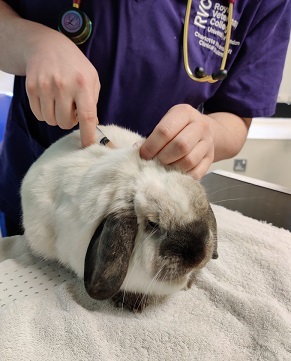Rabbit Vaccination Concerns
Clinical Connections – Spring 2020
By Nadene Stapleton, Veterinary Surgeon (Exotics) at the Beaumont Sainsbury Animal Hospital
Regular vaccinations are accepted as an effective method of preventing many common infectious diseases. In recent years, however, confusion about the most appropriate vaccination protocol and misconceptions regarding “overvaccination” have resulted in reductions in vaccinations.
At the RVC Exotics Service, it is of increasing concern to us how many referral cases remain unvaccinated. These animals belong to highly motivated, dedicated clients, and on discussion, the majority have no objections to vaccination but are either unaware of the necessity or believed it to be unnecessary, based on the recommendations of their primary vets.
In the best scenario, their lack of vaccination is an incidental finding but, in many situations, we are encountering rabbits which are already affected by viral haemorrhagic disease 2 (VHD2). Treatment is supportive only and the disease is often fatal, so prevention is key.

VHD2 is still thought of as a ‘new’ calicivirus strain, but actually seems to have superseded VHD1 in the UK rabbit population. It differs from VHD1 in three main ways. Unlike VHD1, VHD2 can affect wild hares. There is also no age-related protection against VHD2, so kits are susceptible to the disease. Finally, the most important difference for us is that the onset of VHD2 is much more insidious, with incubation periods of three to nine days.
Unlike VHD1, where rabbits often die before veterinary attention is sought, VHD2 rabbits are much more likely to be brought to the veterinary clinic with vague signs of gut stasis and anorexia. This has important consequences, both for the patient and for infection control. Although VHD2 is reported to have a lower mortality rate than VHD1, it is increasing in virulence and the high mutability of caliciviruses makes the evolution of high virulence strains likely. Most rabbits with VHD2 die, although more slowly than with VHD1.
Although PCR testing of blood and faeces is possible, false-negative results do occur. The delay in receiving results means that many of these rabbits will be hospitalised and shedding the virus prior to their death.
Rabbit caliciviruses can survive multiple freeze-thaw cycles, temperatures of 500C and can persist for many months on bedding etc. Immediate barrier nursing of unvaccinated rabbits who present with non-specific illness is advised.
When VHD2 was first detected in the UK, its significance was underestimated, and vaccination was only recommended for “high-risk” areas. However, now cases have been found throughout the UK, VHD2 should be included in the vaccination protocol for all rabbits, and in “higher-risk” areas six-monthly vaccination may be recommended. Vector and fomite spread of these viruses means they can easily gain entry indoors. Therefore, indoor rabbits also require vaccination.
Vaccination protocols for pet rabbits should include protection against myxomatosis and VHD1, as these remain ongoing risks. Unfortunately, although there are three licensed vaccinations available for rabbits in the UK, there is not one single product which covers all three diseases. Two vaccinations are needed, and standard advice is to administer these at least two weeks apart as they have not been tested together.
